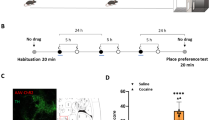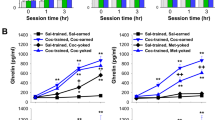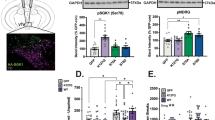Abstract
Neural adaptations in the medial prefrontal cortex (mPFC) are thought to be crucial in the development and maintenance of addictive behaviors. The mPFC receives a dense serotonergic (5-hydroxytryptamine, 5-HT) innervation from raphe nuclei and 5-HT exerts complex actions on mPFC pyramidal neurons. The present study, using a rat model of behavioral sensitization to cocaine, was designed to determine whether repeated cocaine exposure in vivo is capable of altering 5-HT-induced regulation of glutamatergic transmission in the mPFC. In layer V pyramidal neurons of the mPFC, application of 5-HT, through activation of 5-HT2A receptors, induced a massive enhancement of spontaneous excitatory postsynaptic currents (sEPSCs). Repeated cocaine administration for 5 days resulted in an attenuation in the ability of 5-HT to enhance sEPSCs. This effect was prevented when cocaine was co-administered with the selective 5-HT2A receptor antagonist ketanserin and was mimicked by repeated 5-HT2A receptor agonist (−)4-iodo-2,5-dimethoxyphenylisopropylamine administration. Repeated cocaine administration is not associated with any changes in the levels of 5-HT2A receptors or regulator of GTP-binding protein signaling 4. These results suggest that cocaine-induced inhibition of 5-HT2A receptor-mediated enhancement of glutamatergic transmission in the mPFC may be caused, at least in part, by the impairment of coupling of 5-HT2A receptors with GTP-binding proteins during cocaine withdrawal. These alterations in 5-HT2A receptor responsiveness in the mPFC may be relevant to the development of behavioral sensitization and withdrawal effects following repeated cocaine administration.
Similar content being viewed by others
Log in or create a free account to read this content
Gain free access to this article, as well as selected content from this journal and more on nature.com
or
References
Aghajanian GK, Marek GJ (1997). Serotonin induces excitatory postsynaptic potentials in apical dendrites of neocortical pyramidal cells. Neuropharmacology 36: 589–599.
Araneda R, Andrade R (1991). 5-Hydroxytryptamine2 and 5-hydroxytryptamine 1A receptors mediate opposing responses on membrane excitability in rat association cortex. Neuroscience 40: 399–412.
Azmitia EC, Segal M (1978). An autoradiographic analysis of the differential ascending projections of the dorsal and median raphe nuclei in the rat. J Comp Neurol 179: 641–667.
Barr AM, Markou A (2005). Psychostimulant withdrawal as an inducing condition in animal models of depression. Neurosci Biobehav Rev 29: 675–706.
Baumann MH, Rothman RB (1996). Chronic cocaine exposure potentiates prolactin and head shake responses to 5-HT2 receptor stimulation in rats. Neuropharmacology 35: 295–301.
Baumann MH, Rothman RB (1998). Alterations in serotonergic responsiveness during cocaine withdrawal in rats: similarities to major depression in humans. Biol Psychiatry 44: 578–591.
Béïque JC, Chapin-Penick EM, Mladenovic L, Andrade R (2004). Serotonergic facilitation of synaptic activity in the developing rat prefrontal cortex. J Physiol 556: 739–754.
Béïque JC, Imad M, Mladenovic L, Gingrich JA, Andrade R (2007). Mechanism of the 5-hydroxytryptamine2A receptor-mediated facilitation of synaptic activity in prefrontal cortex. Proc Natl Acad Sci USA 104: 9870–9875.
Berg KA, Navailles S, Sanchez TA, Silva YM, Wood MD, Spampinato U et al (2006). Differential effects of 5-methyl-1-[[2-[(2-methyl-3-pyridyl)oxyl]-5-pyridyl]carbamoyl]-6-trifluoromethylindone (SB 243213) on 5-hydroxytryptamine2C receptor-mediated responses. J Pharmacol Exp Ther 319: 260–268.
Beurrier C, Malenka RC (2002). Enhanced inhibition of synaptic transmission by dopamine in the nucleus accumbens during behavioral sensitization to cocaine. J Neurosci 22: 5817–5822.
Bradberry CW, Nobiletti JB, Elsworth JD, Murphy B, Jatlow P, Roth RH (1993). Cocaine and cocaethylene: microdialysis comparison of brain drug levels and effects on dopamine and serotonin. J Neurochem 60: 1429–1435.
Burmeister JJ, Lungren EM, Kirschner KF, Neisewander JL (2004). Differential roles of 5-HT receptor subtypes in cue and cocaine reinstatement of cocaine-seeking behavior in rats. Neuropsychopharmacology 29: 660–668.
Campbell BM, Walker PD (2001). MK-801 prevents dopamine D1 but not serotonin 2A stimulation of striatal preprotachykinin mRNA expression. Neuroreport 12: 953–955.
Carrasco GA, Zhang Y, Damjanoska KJ, D'Souza DN, Garcia F, Battaglia G et al. (2003). A region-specific increase in Galphaq and Galpha11 proteins in brains of rats during cocaine withdrawal. J Pharmacol Exp Ther 307: 1012–1019.
Chen A, Hough CJ, Li H (2003). Serotonin type II receptor activation facilitates synaptic plasticity via N-methyl-D-aspartate-mediated mechanism in the rat basolateral amygdala. Neuroscience 119: 53–63.
Civelli O, Bunzow JR, Grandy DK (1993). Molecular diversity of the dopamine receptors. Annu Rev Pharmacol Toxicol 33: 281–307.
Conductier G, Crosson C, Hen R, Bockaert J, Compan V (2005). 3,4-N-Methlenedioxymethamphetamine-induced hypophagia is maintained in 5-HT1B receptor knockout mice, but suppressed by the 5-HT2C receptor antagonist RS102221. Neuropsychopharmacology 30: 1056–1063.
Dawson LA, Galandak J, Djali S (2002). Attenuation of ischemic efflux of endogenous amino acids by the novel 5-HT1A/5-HT2 receptor ligand adatanserin. Neurochem Int 40: 203–209.
De Vries L, Zheng B, Fischer T, Elenko E, Farquhar MG (2000). The regulator of G protein signaling family. Annu Rev Pharmacol Toxicol 40: 235–2371.
Dong Y, Nasif FJ, Tsui JJ, Ju WY, Cooper DC, Hu XT et al (2005). Cocaine-induced plasticity of intrinsic membrane properties in prefrontal cortex pyramidal neurons: adaptations in potassium currents. J Neurosci 25: 936–940.
Dong Y, Saal D, Thomas M, Faust R, Bonci A, Robinson T et al (2004). Cocaine-induced potentiation of synaptic strength in dopamine neurons: behavioral correlates in GluRA(−/−) mice. Proc Natl Acad Sci USA 101: 14282–14287.
Drouin C, Darracq L, Trovero F, Blanc G, Glowinski J, Cotecchia S et al (2002). α1b-Adrenergic receptors control locomotor and rewarding effects of psychostimulants and opiates. J Neurosci 22: 2873–2884.
Erdely HA, Lahti RA, Lopez MB, Myers CS, Roberts RC, Tamminga CA et al (2004). Regional expression of RGS4 mRNA in human brain. Eur J Neurosci 19: 3125–3128.
Essman WD, Singh A, Lucki I (1994). Serotonergic properties of cocaine: effects on a 5-HT2 receptor-mediated behavior and on extracellular concentrations of serotonin and dopamine. Pharmacol Biochem Behav 49: 107–113.
Filip M, Nowak E, Papla I (2001). On the role of serotonin2A/2C receptors in the sensitization to cocaine. J Physiol Pharmacol 52: 471–481.
Fletcher PJ, Grottick AJ, Higgins GA (2002). Differential effects of the 5-HT2A receptor antagonist M100907 and the 5-HT2C receptor antagonist SB242084 on cocaine-induced locomotor activity, cocaine self-administration and cocaine-induced reinstatement of responding. Neuropsychopharmacology 27: 576–586.
Gainetdinov RR, Premont RT, Bohn LM, Lefkowitz RJ, Caron MG (2004). Desensitization of G protein-coupled receptors and neuronal functions. Annu Rev Neurosci 27: 107–144.
Gu Z, Jiang Q, Yan Z (2007). RGS4 modulates serotonin signaling in prefrontal cortex and links to serotonin dysfunction in a rat model of schizophrenia. Mol Pharmacol 71: 1030–1039.
Huang CC, Hsu KS (2006). Presynaptic mechanism underlying cAMP-induced synaptic potentiation in medial prefrontal cortex pyramidal neurons. Mol Pharmacol 69: 846–856.
Huang CC, Lin HJ, Hsu KS (2007a). Repeated cocaine administration promotes long-term potentiation induction in rat medial prefrontal cortex. Cereb Cortex 17: 1877–1888.
Huang CC, Yang PC, Lin HJ, Hsu KS (2007b). Repeated cocaine administration impairs group II metabotropic glutamate receptor-mediated long-term depression in rat medial prefrontal cortex. J Neurosci 27: 2958–2968.
Hyman SE (1996). Addiction to cocaine and amphetamine. Neuron 16: 901–904.
Hyman SE, Malenka RC, Nestler EJ (2006). Neural mechanisms of addiction: the role of reward-related learning and memory. Annu Rev Neurosci 29: 565–598.
Inoue T, Itoh S, Kobayashi M, Kang Y, Matsuo R, Wakisaka S et al (1999). Serotonergic modulation of the hyperpolarizing spike afterpotential in rat jaw-closing motoneurons by PKA and PKC. J Neurophysiol 82: 626–637.
Kalivas PW, Duffy P (1998). Repeated cocaine administration alters extracellular glutamate in the ventral tegmental area. J Neurochem 70: 1497–1502.
Kauer JA, Malenka RC (2007). Synaptic plasticity and addiction. Nat Rev Neurosci 8: 844–858.
Lambe EK, Aghajanian GK (2001). The role of Kv1.2-containing potassium channels in serotonin-induced glutamate release from thalamocortical terminals in rat frontal cortex. J Neurosci 21: 9955–9963.
Levy AD, Li Q, Alvarez Sanz MC, Rittenhouse PA, Brownfield MS, Van de Kar LD (1992). Repeated cocaine modifies the neuroendocrine responses to the 5-HT1C/5-HT2 receptor agonist DOI. Eur J Pharmacol 221: 121–127.
Marek GJ, Wright RA, Gewirtz JC, Schoepp DD (2001). A major role for thalamocortical afferents in serotonergic hallucinogen receptor function in the rat neocortex. Neuroscience 105: 379–392.
McMahon LR, Cunningham KA (2001). Antagonism of 5-hydroxytryptamine2A receptors attenuates the behavioral effects of cocaine in rats. J Pharmacol Exp Ther 297: 357–363.
Meert TF, Awouters F, Niemegeers CJ, Schellekens KH, Janssen PA (1991). Ritanserin reduces abuse of alcohol, cocaine, and fentanyl in rats. Pharmacopsychiatry 24: 159–163.
Nasif FJ, Hu XT, White FJ (2005). Repeated cocaine administration increases voltage-sensitive calcium currents in response to membrane depolarization in medial prefrontal cortex pyramidal neurons. J Neurosci 25: 3674–3679.
Nestler EJ (2002). From neurobiology to treatment: progress against addiction. Nat Neurosci 5 (Suppl): 1076–1079.
Nishimura J, Kanaide H, Shogakiuchi Y, Nakamura M (1987). Ketanserin blocks α1-adrenoceptors of porcine vascular smooth muscle cells. Eur J Pharmacol 133: 235–238.
Peterson JD, Wolf ME, White FJ (2006). Repeated amphetamine administration decreases D1 dopamine receptor-mediated inhibition of voltage-gated sodium currents in the prefrontal cortex. J Neurosci 26: 3164–3168.
Pierce RC, Bell K, Duffy P, Kalivas PW (1996). Repeated cocaine augments excitatory amino acid transmission in the nucleus accumbens only in rats having developed behavioral sensitization. J Neurosci 16: 1550–1560.
Ross EM, Wilkie TM (2000). GTPase-activating proteins for heterotrimeric G proteins: regulators of G protein signaling (RGS) and RGS-like proteins. Annu Rev Biochem 69: 795–827.
Roth BL (1994). Multiple serotonin receptors: clinical and experimental aspects. Ann Clin Psychiatry 6: 67–78.
Sesack SR, Deutch AY, Roth RH, Bunney BS (1989). Topographical organization of the efferent projections of the medial prefrontal cortex in the rat: an anterograde tract-tracing study with Phaseolus vulgaris leucoagglutinin. J Comp Neurol 290: 213–242.
Shi J, Damjanoska KJ, Singh RK, Carrasco GA, Garcia F, Grippo AJ et al (2007a). Agonist induced-phosphorylation of Galpha11 protein reduces coupling to 5-HT2A receptors. J Pharmacol Exp Ther 323: 248–256.
Shi J, Zemaitaitis B, Muma NA (2007b). Phosphorylation of Gα11 protein contributes to agonist-induced desensitization of 5-HT2A receptor signaling. Mol Pharmacol 71: 303–313.
Steketee JD (2003). Neurotransmitter systems of the medial prefrontal cortex: potential role in sensitization to psychostimulants. Brain Res Brain Res Rev 41: 203–228.
Teneud LM, Baptista T, Murzi E, Hoebel BG, Hernandez L (1996). Systemic and local cocaine increase extracellular serotonin in the nucleus accumbens. Pharmacol Biochem Behav 53: 747–752.
Thomas MJ, Malenka RC (2003). Synaptic plasticity in the mesolimbic dopamine system. Philos Trans R Soc Lond B Biol Sci 358: 815–819.
Tzschentke TM (2001). Pharmacology and behavioral pharmacology of the mesocortical dopamine system. Prog Neurobiol 63: 241–320.
Wellman P, Ho D, Cepeda-Benito A, Bellinger L, Nation J (2002). Cocaine-induced hypophagia and hyperlocomotion in rats are attenuated by prazosin. Eur J Pharmacol 455: 117–126.
Wolf ME (1998). The role of excitatory amino acids in behavioral sensitization to psychomotor stimulants. Prog Neurobiol 54: 679–720.
Yan Q, Reith ME, Yan S (2000). Enhanced accumbal dopamine release following 5-HT2A receptor stimulation in rats pretreated with intermittent cocaine. Brain Res 863: 254–258.
Zhou FM, Hablitz JJ (1999). Activation of serotonin receptors modulates synaptic transmission in rat cerebral cortex. J Neurophysiol 82: 2989–2999.
Acknowledgements
This work was supported by research grants (NSC97-2321-B-006-002-MY2; principal investigator, CCH and NSC97-2752-B-006-002-PAE; principal investigator, KSH) from the National Science Council, Taiwan. We thank Dr TP Su for critical comments on an earlier version of this paper.
Author information
Authors and Affiliations
Corresponding authors
Additional information
DISCLOSURE/CONFLICT OF INTEREST
The authors declare that there are no actual or potential conflicts of interest. The authors affirm that there are no financial, personal, or other relationships with other people or organizations that have inappropriately influenced or biased the work.
Supplementary Information accompanies the paper on the Neuropsychopharmacology website (http://www.nature.com/npp)
Supplementary information
Rights and permissions
About this article
Cite this article
Huang, CC., Liang, YC., Lee, CC. et al. Repeated Cocaine Administration Decreases 5-HT2A Receptor-Mediated Serotonergic Enhancement of Synaptic Activity in Rat Medial Prefrontal Cortex. Neuropsychopharmacol 34, 1979–1992 (2009). https://doi.org/10.1038/npp.2009.10
Received:
Revised:
Accepted:
Published:
Issue date:
DOI: https://doi.org/10.1038/npp.2009.10
Keywords
This article is cited by
-
Cocaine-related behaviors in mice with deficient gliotransmission
Psychopharmacology (2013)



